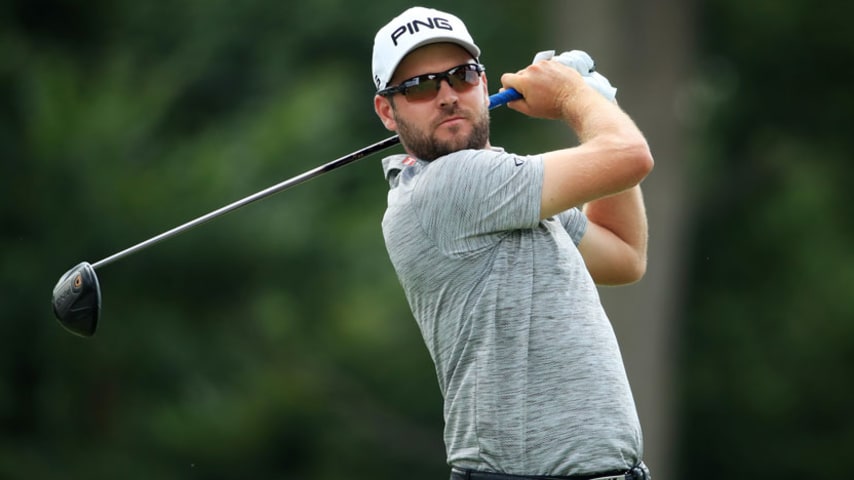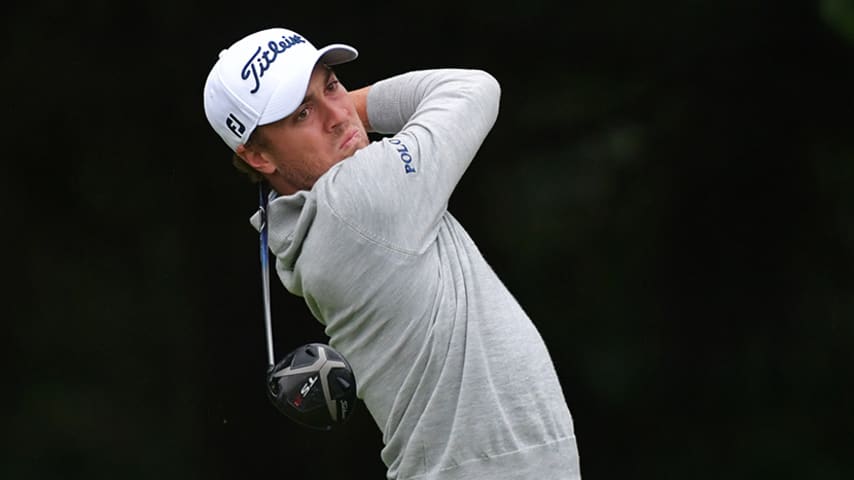No risk, lots of reward, for FedExCup pursuers
8 Min Read

Written by Sean Martin

New format for 2019 FedExCup Playoffs
ATLANTA – Corey Conners graduated from Kent State five years ago with a degree in actuarial mathematics. That education will be useful at this week’s TOUR Championship.
Conners, who’s 23rd in the FedExCup standings, has four rounds to make up nine strokes on leader Justin Thomas. Players are accustomed to starting tournaments on equal footing, but an unprecedented staggered start is being used this week to reward players for their season-long performance.
Actuaries analyze the financial consequences of risk. A lot of money is on the line at East Lake – the winner will receive a record $15 million -- and the players, like Conners, at the back of the pack must calculate the proper way to overcome a big deficit on a demanding layout.
There’s nothing to lose, and everything to gain. The only question is how to make up those strokes.
Don’t expect drastically different gameplans, especially in the early rounds, though. East Lake isn’t a course that offers a lot of risk-reward opportunities. Instead, it’s a straightforward layout that rewards repetitive execution. Plodding along with pars and taking advantage of the occasional birdie opportunity is the best way to succeed here. Professional golfers are a conservative bunch by nature, and they aren’t convinced that slamming on the gas pedal for 72 holes is the best strategy at the season finale.
“I don’t think I’m really going to change my game plan too much,” Conners said. “I’m going to try to make a lot of birdies. Starting in this position, there’s really nothing to lose. You can’t be silly, but if I can put four really good rounds of golf together, I have a chance. I think everyone feels like they have a chance.”
Since 1983, there have been 19 victories by players who trailed by 10 or more strokes after any round. Nine players won when trailing by 10 or more strokes with 54 holes remaining, while seven players did so with two rounds left to play.
Steve Jones (1987) and Corey Pavin (1989) won the Desert Classic after trailing by 11 shots with four rounds remaining (the tournament was 90 holes back then).
Lucas Glover, who’s making his first TOUR Championship appearance in a decade, also said he won’t treat Thursday’s first round any differently.
“If I can hit it at the hole, I do. If I can’t, I won’t,” he said. “Come Saturday, Sunday, it might change things, but I don’t think Thursday is going to be that much different.”
Glover is one of five players who will start the TOUR Championship at even par, 10 shots behind Thomas. Jason Kokrak, Charles Howell III, Louis Oosthuizen and Bryson DeChambeau will join him in a tie for 26th place, at the bottom of the leaderboard.
Glover is accustomed to spotting players strokes back home at The Bear’s Club in Jupiter, Florida. He gives his most frequent playing partner four shots a side. But now he’s giving shots to some of the best players in the world. He’s eight shots behind Patrick Cantlay, seven shots back of Brooks Koepka, trails Patrick Reed by six shots and is five behind Rory McIlroy.
Howell is one of the game’s most analytical players. He knows the odds aren’t in his favor.
“Frankly speaking, I haven’t beaten Brooks Koepka much starting level with him,” Howell said.
Reaching the top spot on the leaderboard may seem like an impossible climb, but this week’s top-heavy purse incentivizes players to try to make a move. For the players at the bottom of the leaderboard, the benefits of moving up a spot far outweigh the consequences of a dropped shot. That’s why Golf Channel’s Roger Maltbie sees only one option for the pursuing pack.
“I would think those guys 10 back, yeah, they’ve got to come out and play aggressively. They have to,” he said. “That’s the job they have to get done. What the heck, if it doesn’t work, they’re not walking out of here busted.”
Second place this week pays $5 million. Third place earns $4 million, while fourth place earns $3 million and the No. 5 finisher takes home $2.5 million.
Eight players will earn more than $1 million this week. Last place is worth $395,000.
The fact that this is the last event of the season – with nothing to play for beyond this week – and the worst-case scenario is a paycheck of nearly $400,000 should give the pursuers an increased sense of freedom.
Mark Broadie, the inventor of the TOUR’s Strokes Gained statistics, summed it up succinctly: “There’s nothing to lose, so players should be slightly more aggressive.”
The people like Broadie who dig through the ShotLink data to help players formulate their strategies do recommend players take a different approach this week.
There’s only so much a player can do, especially at East Lake, to try to force a lower score, though. At the end of the day, it’s about getting as many birdie putts as possible and hoping the putter gets hot.
East Lake is a rather straightforward design where players have traditionally hit a lot of drivers. There aren’t a lot of holes where a player must decide between playing safe with a fairway wood off the tee or taking a risk with a driver to gain an exponential advantage. Most of the holes are fairly straight and there are very few penalty areas in play off the tee.
Jake Nichols of the golf analytics firm 15th Club recommended that the pursuers should make the driver their default pick off the tee. The exception would be a hole where a bunker or penalty area severely narrows the landing area.
“There’s not a ton of downside for Jason Kokrak to pump it out there,” he said. “Top five on the leaderboard is what guys should be targeting. That’s where the big money is.
“This week, if you can send it or play aggressively, that’s the smart numbers play. Can you say to yourself, and believe it, that this is a totally different week?”
Nichols also recommends that pursuers give a little extra pace to their putts to ensure they don’t leave them short.
Golf statistician Richie Hunt, who works for multiple TOUR players, has found that players who trail by a large margin have a tendency to hit their putts with more speed and play more aggressively off the tee. It has to do with the economic phenomenon of loss aversion, which refers to humans’ preference of avoiding loss over acquiring equivalent gains.
In other words, the pain felt from losing $5 outweighs the joy of finding the same amount of money.
Hunt found that players who squeaked inside a cut line played more aggressively than those who started the weekend with the lead, especially a large one. The players who barely make a cut have nothing to lose and everything to gain. The opposite is true of players who are nervous about the embarrassment of blowing a big lead. He thinks that phenomenon will continue this week. The leaders could be anxious about losing to their peers after spotting them strokes.
He recommends that players aim their approach shots closer to the flag, but not by much. He has a ratio that determines a TOUR player’s average proximity from the hole for any distance between 80 and 220 yards. Just multiply the yardage by 0.18 (for example, 150 yards x 0.18 = 27 feet). Multiplying the distance by 0.15 gives a good estimate for how many feet offline a player hits his shots from any distance (150 yards x 0.15 = 22.5 feet).
“For a player in this situation (at the bottom of the TOUR Championship leaderboard), I would play closer to the average off-line versus the average proximity,” Hunt said. “If you have a pin that’s 23 feet from the edge of the green, I would probably fire at that flag. If I was playing it more toward the proximity to the hole, I wouldn’t aim at a flag unless it was 27 feet from the edge of the green. I would aim it a little more toward the center of the green.”
Players who from 150 yards start aiming at flags that are five paces off the edge of the green have crossed the line to recklessness.
“With the way dispersion and probabilities work, reckless to me is any time luck plays a larger role than skill,” Hunt said. “A lot of it comes down to execution still.”
At the end of the day, the best strategy is the same two words that offer the solution to any problem faced by a professional golfer: play better. Better results during the rest of the season would have more benefit than any strategy employed at the season finale.
“You can’t intentionally make 10 extra birdies without getting bit in the ass some,” said Scott Fawcett, whose DECADE system helps players plot a course-management strategy. “You’re not going to make enough birdies to offset the increased amount of bogeys.
“I always tell people who are 3 down with three holes left that they should have played better on the first 15 holes. There’s nothing you’re going to do to offset that. You should have played better the rest of the year. All you can hope for now is a hot putter and a little positive variance with your approach-shot dispersion.”












